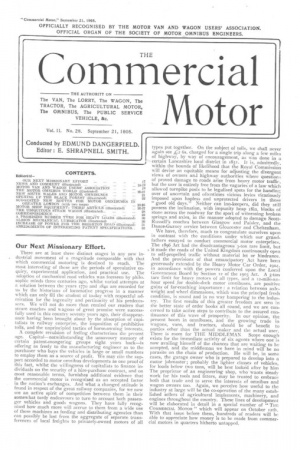Our Next Missionary EYfort.
Page 1

If you've noticed an error in this article please click here to report it so we can fix it.
There are at least three distinct stages in any new industrial movement of a magnitude comparable with that which commercial motoring is destined to reach. The most interesting of these are the periods of speculative enquiry, experimental application, and practical use. The adoption of mechanical road vehicles was foreseen by philosophic minds three centuries ago, whilst varied attempts at a solution between the years 1770 and 1840 are recorded for us by the historians of locomotive progress in a manner which can only fill the student of to-day with respectful admiration for the ingenuity and pertinacity of his predecessors. We will not do more than remind our readers that steam coaches and v. agons of great promise were successfully used in this country seventy years ago, their disappearance having been brought about by the absorption of capitalists in railway enterprise, the imposition of prohibitive tolls, and the unprincipled tactics of horse-owning interests.
A complete revulsion of feeling characterises the present age. Capital—notwithstanding the unsavoury memory cit certain patent-mongering groups eight years back—is offering as freely to the manufacturing engineer as to the purchaser who buys the vehicles in large or small numbers to employ them as a source of profit. We may cite the support accorded to motor omnibus developments as one proof of this fact, whilst the willingness of capitalists to finance individuals on the security of a hire-purchase contract, and on most reasonable terms, furnishes additional evidence that the commercial motor is recognised as an accepted factor in the nation's exchanges. And what a changed attitude is found in respect of the great railway companies, for we now see an active spirit of competition between them in their somewhat tardy endeavours to turn to account both passenger vehicles and goods wagons. They have fully recognised how much more will accrue to them from a wide use of these machines as feeding and distributing agencies than can possibly be lost from the aggregate of separate transferences of local freights to privately-owned motors of all types put together. On the subject of tolls, we shall never again see L:2 65. charged for a single trip along a few miles of highway, by way of encouragement, as was done in a certain Lancashire local district in 1831. It is, admittedly, within the bounds of likelihood that the Royal Commission will devise an equitable means for adjusting the divergent views of owners and highway authorities where questions of proved damage to roads arise from heavy motor traffic, but the user is entirely free from the vagaries of a law which allowed turnpike posts to be legalised spots for the handing over of uncertain and oftentimes vicious levies vicariously imposed upon hapless and unprotected drivers in those "good old days." Neither can inn-keepers, did they still possess the inclination, with impunity heap 18in. blocks of stone across the roadway for the sport of witnessing broken springs and axles, in the manner adopted to damage ScottRussell's coaches between Glasgow and Paisley, and the Dance-Gurney service between Gloucester and Cheltenham.
We have, therefore, much to congratulate ourselves upon in contrast with the conditions under which our grandfathers essayed to conduct commercial motor enterprises_ The 1896 Act had the disadvantageous 3-ton tare limit, but . it made the roads of the United Kingdom continuously open to self-propelled traffic without material let or hindrance. And the provisions of that emancipatoy Act have been generously extended by the Heavy Motor Car Order, 19o./, in accordance with the powers conferred upon the Local Government Board by Section 12 of the 1903 Act. A 5-ton tare limit for heavy motors of all types, and a 12-mile-anhour speed for double-deck motor omnibuses, are positive gains of far-reaching importance : a relation between axleweight and wheel dimensions, which was the principal fresh condition, is sound and in no way hampering to the industry. The first results of this greater freedom are seen in the better state of order books all round, and we are concerned to take active steps to contribute to the assured continuance of this wave of prosperity. In our opinion, the present boom in omnibuses, and the growing trade in wagons, vans, and tractors, should be of benefit to parties other than the actual maker and the actual user. There is room for THE MIDDLEMAN Scope enough exists for the immediate activity of six agents where one is now availing himself of the chances that are waiting to be accepted, and the middleman we have in mind will be no parasite on the chain of production. He will be, in some cases, the garage owner who is prepared to develop into a motor jobmaster; probably the lighter classes of vehicles, for loads below two tons, will be best looked after by him The proprietor of an engineering shop, who wants steady work for his tools and fitters, may be trusted to embrace both that trade and to serve the interests of omnibus and wagon owners too. Again, we perceive how useful to the industry at large will be the co-operation of the many established sellers of agricultural implements, machinery, and engines throughout the country. These lines of development will be elaborated in detail in a special number of "THE COMMERCIAL MOTOR" which will appear on October 12th. With that issue before them, hundreds of readers will be able to appreciate how money is to be made from commercial motors in quarters hitherto untapped.
















